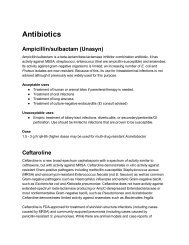Skin and Soft Tissue Infections - UCLA
Skin and Soft Tissue Infections - UCLA
Skin and Soft Tissue Infections - UCLA
Create successful ePaper yourself
Turn your PDF publications into a flip-book with our unique Google optimized e-Paper software.
Aztreonam +<br />
Clindamycin. If concern<br />
for MRSA, use<br />
vancomycin instead of<br />
clindamycin <strong>and</strong> add<br />
anaerobic coverage with<br />
metronidazole.<br />
TREATMENT NOTES<br />
Microbiology<br />
● S. aureus <strong>and</strong> Streptococci (especially Group A)<br />
● Rare causes of cellulitis are discussed below<br />
Management<br />
● Always elevate the affected extremity. Treatment failure is more commonly due to failure<br />
to elevate than failure of antibiotics.<br />
● Improvement of erythema can take days, especially in patients with venous stasis or<br />
lymphedema, because dead bacteria in the skin continue to induce inflammation.<br />
● The microbiology laboratory routinely tests S. aureus isolates for inducible Clindamycin<br />
resistance <strong>and</strong> this testing is reflected in the reported susceptibility data. If no culture<br />
data to guide therapy <strong>and</strong> high risk or suspicion of CA-MRSA or failure to improve on<br />
clindamycin, change clindamycin to alternate active agent such as bactrim or<br />
doxycycline.<br />
● Resistance to fluoroquinolones in S. aureus is common <strong>and</strong> develops quickly. The vast<br />
majority of MRSA isolates are resistant to fluoroquinolones. Therapy with<br />
fluoroquinolones for S. aureus infections is not recommended.<br />
● Rifampin should NEVER be used as monotherapy because resistance develops rapidly.<br />
● There is NO EVIDENCE that linezolid or daptomycin are superior to TMP/SMX,<br />
doxycycline, or clindamycin for the management of skin <strong>and</strong> soft tissue infections.<br />
Linezolid or daptomycin should only be considered when the S. aureus isolate is<br />
resistant to other agents or the patient is intolerant of these agents.<br />
● Elimination or prevention of interdigital tinea is important for cases of relapsing lower<br />
extremity cellulitis.<br />
● Specialty referral should be considered in cases of lymphedema, refractory tinea pedis,<br />
chronic dermopathies, venous insufficiency, or post-surgical cellulitis.<br />
Other causes of cellulitis in select patient populations<br />
● With bullae, vesicles, <strong>and</strong> ulcers after exposure to seawater or raw oysters, consider<br />
Vibrio vulnificus, especially in patients with chronic liver disease. Rare, but rapidly fatal if<br />
untreated. Treat with ceftriaxone 1 g IV q24h PLUS doxycycline 100 mg PO BID.<br />
● Neutropenic, solid organ transplant, <strong>and</strong> cirrhotic patients may have cellulitis due to<br />
gram-negative organisms. Consider exp<strong>and</strong>ing coverage in these cases. Gram-negative<br />
cellulitis is exceedingly rare in other patient populations <strong>and</strong> routine gram-negative<br />
coverage is unnecessary.





